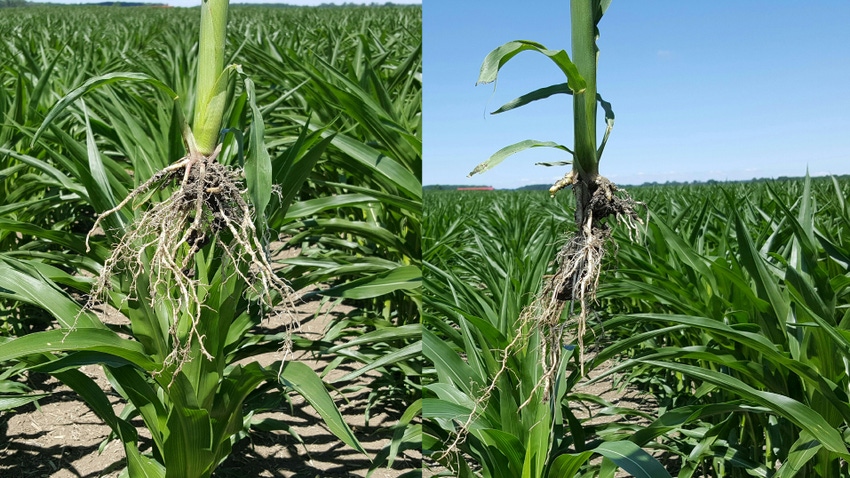February 13, 2018

Large-scale farm equipment can set the stage for poor emergence, wasted seed, stunted root mass and lost yield. On-farm equipment evaluations by Ohio State University (OSU) have identified the impact of pinch-row compaction (middle six rows of the planter, next to transport tires) on corn caused by large center-filled planters and the tractors that pull them.
"We have problems with large axle loads throughout the production system from tractor and planters to grain carts, combines and sprayers," says Andrew Klopfenstein, ag engineer, OSU. "We know the grain cart is the biggest problem because it crosses the field regardless of soil conditions. Planting is usually done in the best of soil conditions; yet it too can have a significant impact on plant emergence, crop vigor, and yield potential.”
Tires versus tracks
To evaluate how much impact the pinch-rows had and how it could be reduced, Klopfenstein used a 16-row John Deere 1775 NT center-fill planter with a Yetter fertilizer cart, running it on wheels and then converting the planter to use Soucy tracks. It featured Martin floating row cleaners, factory 2x2 coulters, ExactEmerge and ground-drive starter fertilizer.
In 2016, the on-farm research included seven swath sets of half-full seed loads and full seed loads, with the planter on both wheels and tracks, evaluated by soil type. In 2017, six swaths had four configurations of tractor and planter on wheels and tracks that were analyzed on different soil types.
More plants with tracks
In both years, adding tracks to the planter delivered more bushels on lighter Kokomo silty clay loam soils, up to 10 to 12 bushels more per acre compared to wheeled planter pinch-rows (see chart for 2016 yields). Perhaps more significant was the reduced emergence seen in 2016 under ideal planting conditions, according to the farmer. Of 34,000 seeds/acre planted in light soils, actual population was 27,037 in the wheeled planter pinch-row zone versus 31,597 with tracks and 33,500 in the control zone (outside rows of planter).

Ideal planting conditions. Light soil: Kokomo silty clay loam. Dark soil: Crosby-Lewisburg complex.
Emergence on darker soils (Crosby-Lewisburg complex) that year showed only a slight decrease compared to the control (33,027 track; 32,096 wheel; 33,534 control).
In 2017, putting tracks on the tractor also had an impact on yield, but not as great as putting tracks on the planter. In 2016 under ideal soil conditions, the research noted that tracks caused 0.5 to 0.75 inch depressions in worked soil, while tires caused 1 to 3 inch depressions.
"When we show a 20% reduction in emergence between the planter on wheels and the planter on tracks on light soils, it gets a farmer's attention," says Klopfenstein. "If you're short 7,000 plants, it is evident one could lose yield. Add to that a significantly smaller root mass in the wheeled planter pinch-row zones compared to track zones or controls, you are more susceptible to drought stress, pests and/or wind damage affecting yield potential. If you have no brace roots to hold the plant and provide nutrient uptake and strength, lodging could occur."
About the Author(s)
You May Also Like




